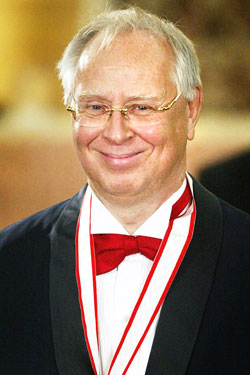
When Sigmar Polke, giant of the postwar art world, passed away on Friday, New YorkÔÇÖs Jerry Saltz asked artists, critics, and curators to remember him. WeÔÇÖve collected many of their thoughts below.
Michael Wilson, critic: In October 1964, Polke composed a fake interview between my grandfather, British critic John Anthony Thwaites, and Gerhard Richter, in which he portrays his fellow painter as having made work so powerful that it caused ÔÇ£dumbness, hair loss (mainly in women) and paralysis of limbs.ÔÇØ
William Powhida, artist: Polke was an iconoclast. His legacy is as important as it is instructive; never rest and never settle into mannerism. I, for one, am still learning. Thank you, Sigmar.
Peter Plagens, critic and artist: Very, very few artists can be all over the place ÔÇö especially within a mode, such as painting/drawing ÔÇö and make it work. Polke did. I wasnÔÇÖt immediately convinced (too much of that very German IÔÇÖm-too-blunt-and-arbitrary-to-show-off kind of showing off), but the relentlessness and complexity of his sneaky sort of power eventually won me over.
John Cheim, dealer: I remember when Polke was first seen by American audiences as a ÔÇ£Pattern and DecorationÔÇØ artist at Holly SolomonÔÇÖs. In fact, he is our Goya. If anyone could manage to capture the tragedy of the oil spill in the Gulf, it would be Polke.
 
Dave Hickey, critic: Very good guy, whom I liked very much. Seventy percent good art, which is very high. Segued from dark wizard to Santa Claus without really changing. Mounted a show at the┬áDallas Museum of Art so his son and his sonÔÇÖs friends could watch Dirk Nowitski play basketball ÔÇö thatÔÇÖs a really cool dad. Bye-Bye, Sigmar.
Gavin Brown, dealer: Great loss for all humans on the planet. Though so few will know, his passing is invisible. A cosmic secret.
Mary Heilmann, artist: I saw the show at HollyÔÇÖs and remember┬áthe spots and the printed fabric and totally fell in love ÔÇö abstract with hints of narrative. Two heroes have┬ápassed in the last two months: Polke and McLaren.┬áI guess they never met.
Martha Schwendener, critic: The early seventies photographs he printed while he was on LSD, so that the artist was being chemically processed as well as the images. Is there a better example of linking art and altered perception during that era?
Aaron Holz, artist: ÔÇ£We cannot rely on it that good painting will be made one day. We, have to take the matter in hand ourselves.ÔÇØ ÔÇöSigmar Polke
Lisa Beck, artist: Polke is important because of his disinterest in narrowing things down, and his supreme ability in evading boundaries and definitions. His work is the ultimate rejection of either/or. His refusal to maintain a single recognizable style or brand for his fantastically kaleidoscopic output with its varied mediums, idioms, and unheard-of combinations has been for me an inspiring antidote to the coffee-table book version of art history and artists oeuvres: not a linear ÔÇ£then, and then, and then, and then,ÔÇØ but a multivalent ÔÇ£also, and also, and also, and also.ÔÇØ His works are not finished products, they are encapsulations of the kind of overlapping, concurrent experience that life really is.
┬áErik Parker, artist: He was godfather of the ÔÇ£I donÔÇÖt get it but I like itÔÇØ aesthetic. Without him we would have no Kippenberger.
Chrissie Iles, Whitney Museum Curator, after seeing Polke paint in his studio in 2007: Polke is mysterious. He is self-contained yet generous, quiet yet funny, thoughtful, self-effacing yet powerful; sensitive and sharply alert. He is his own man. He has an internal rhythm to which others around him listen and adjust. He knows what a gift has been given to him, and he executes the responsibility he has to use it with impressive grace and a formidable strength.┬áHe is very attractive to women, yet he does not particularly assert it. I donÔÇÖt like using terms like ÔÇ£master,ÔÇØ but Polke is a master; he knows it, and we know it. He paces slowly and deliberately round the studio like an old lion, king of his domain. When we finally leave, after a glass of Champagne and many warm thanks, looking forward to dinner together later, he walks us to the gate and waits with us for the taxi, then, as we turn round and drive back past his gate, he is still standing there, waiting for us, waving us good-bye.
Richard Phillips, artist: Sigmar PolkeÔÇÖs art showed that the form of painting could possess and command the outer limits of expressive and conceptual agendas simultaneously and WITHOUT the compulsion to rationalize narratives or explain its reason for being. He inherently trusts oneÔÇÖs capacity to be inspired by the incongruent, the cosmically unattainable, and the comical present in our visual life.
Allison Katz, artist: Sigmar PolkeÔÇÖs paintings always seemed drunk on themselves; drunk on their own generative, spiraling sense of humor; their joyful but pointed abundance; the gravitas of their material jokes. He stayed curious about his own edge, even if he never got far from the reflective pool. He was like a hairy spider in the center of a dew-covered web, surrounded by loads of shimmering flies.
Ashley Bickerton, artist: A freak of the grandest order.

